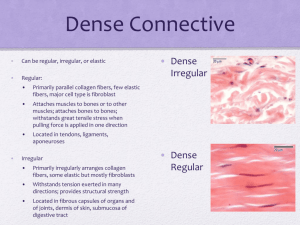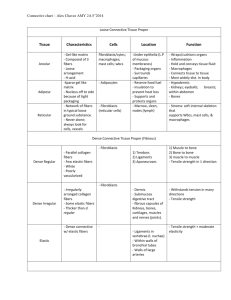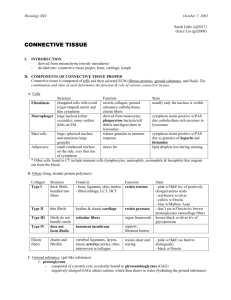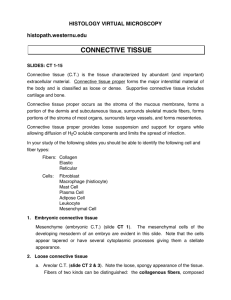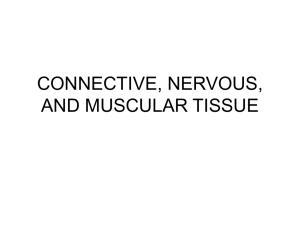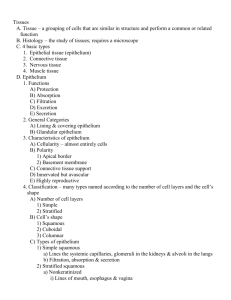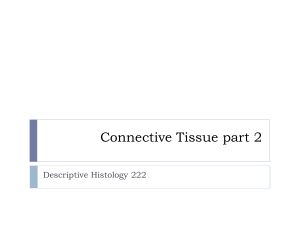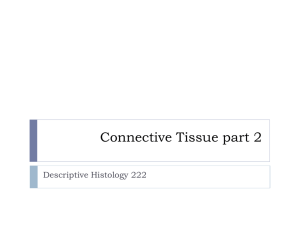(areolar) connective tissue
advertisement
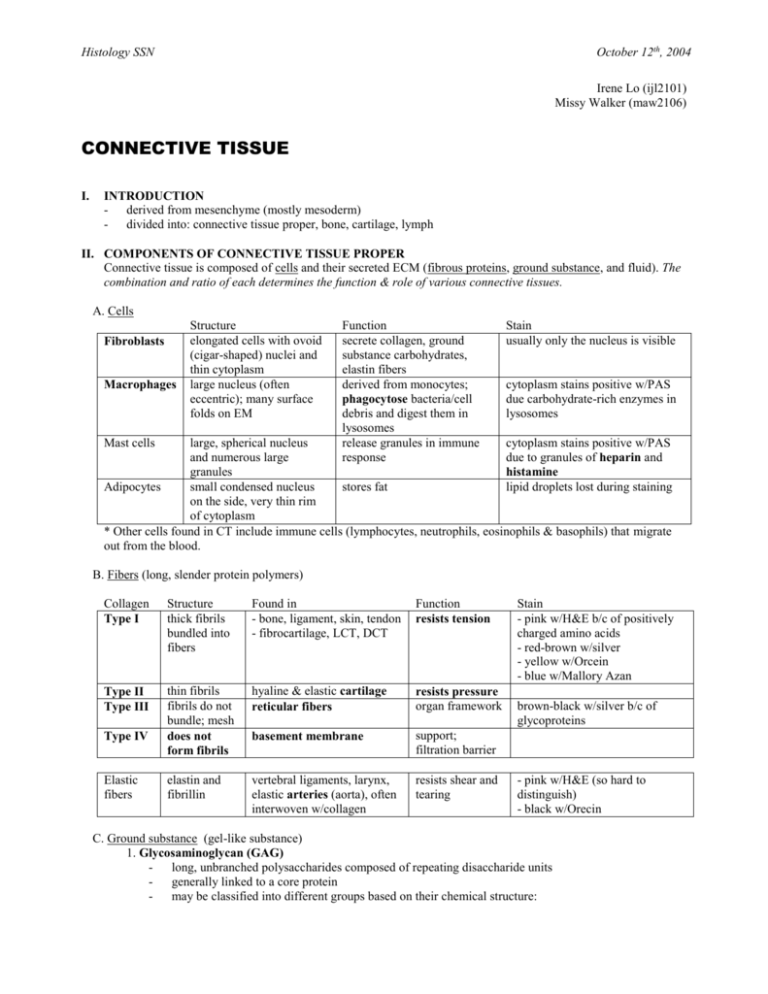
October 12th, 2004 Histology SSN Irene Lo (ijl2101) Missy Walker (maw2106) CONNECTIVE TISSUE I. INTRODUCTION - derived from mesenchyme (mostly mesoderm) - divided into: connective tissue proper, bone, cartilage, lymph II. COMPONENTS OF CONNECTIVE TISSUE PROPER Connective tissue is composed of cells and their secreted ECM (fibrous proteins, ground substance, and fluid). The combination and ratio of each determines the function & role of various connective tissues. A. Cells Fibroblasts Macrophages Structure elongated cells with ovoid (cigar-shaped) nuclei and thin cytoplasm large nucleus (often eccentric); many surface folds on EM Mast cells Function secrete collagen, ground substance carbohydrates, elastin fibers derived from monocytes; phagocytose bacteria/cell debris and digest them in lysosomes release granules in immune response Stain usually only the nucleus is visible cytoplasm stains positive w/PAS due carbohydrate-rich enzymes in lysosomes large, spherical nucleus cytoplasm stains positive w/PAS and numerous large due to granules of heparin and granules histamine Adipocytes small condensed nucleus stores fat lipid droplets lost during staining on the side, very thin rim of cytoplasm * Other cells found in CT include immune cells (lymphocytes, neutrophils, eosinophils & basophils) that migrate out from the blood. B. Fibers (long, slender protein polymers) Collagen Type I Structure thick fibrils bundled into fibers Found in - bone, ligament, skin, tendon - fibrocartilage, LCT, DCT Function resists tension Type II Type III thin fibrils fibrils do not bundle; mesh does not form fibrils hyaline & elastic cartilage reticular fibers resists pressure organ framework basement membrane support; filtration barrier elastin and fibrillin vertebral ligaments, larynx, elastic arteries (aorta), often interwoven w/collagen resists shear and tearing Type IV Elastic fibers Stain - pink w/H&E b/c of positively charged amino acids - red-brown w/silver - yellow w/Orcein - blue w/Mallory Azan brown-black w/silver b/c of glycoproteins - pink w/H&E (so hard to distinguish) - black w/Orecin C. Ground substance (gel-like substance) 1. Glycosaminoglycan (GAG) long, unbranched polysaccharides composed of repeating disaccharide units generally linked to a core protein may be classified into different groups based on their chemical structure: Histology SSN October 12th, 2004 A. hyaluronic acid * very large, nonsulfated molecule * not attached directly to a core protein * attached to the core proteins via linker proteins B. chondroitin sulfate * attached directly to the core protein C. keratan sulfate * attached directly to the core protein 2. Proteoglycans - composed of a protein core covalently bound to many glycosaminoglycans (GAG) A. large molecules shaped like a bottle brush - proteoglycans may attach to hyaluronic acid, via their core proteins, to form large, complex aggregates - negatively-charged GAGs attract cations, which then draws in water (hydrating the ground substance) 3. Glycoproteins - includes fibronectin & laminin A. fibronectin – multifunctional molecule * mediates cell adhesion to the ECM by binding to fibronectin receptors on the cells surface * has domains for binding collagen, heparin, various cell-surface receptors, and celladhesion molecules B. laminin – mediates interactions between epithelial cells and ECM by anchoring cell surface to the basal lamina HYALURONATE PROTEOGLYCAN AGGREGATE III. TYPES OF CONNECTIVE TISSUE PROPER A. Classification: 1. based on the proportion of cells to fibers as well as on the arrangement and type of fibers - need to think about the following: cells fibers ground substance B. loose (areolar) connective tissue 1. characteristics: - many cells per unit volume (highly cellular) - mostly fibroblasts - includes many macrophages, lymphocytes, mast cells etc. - abundant ground substance - sparse collagen fibers (elastic, reticular) - well vascularized (by both blood & lymph) 2. location: found beneath many epithelia (e.g. the lamina propria of GI tract) 3. specialized types: a. adipose tissue i. white adipose tissue – unilocular adipocytes ii. brown adipose tissue – mutlilocular adipocytes & many mitochondria (help in heat production) b. reticular tissue - distinctive black appearance when stained w/silver salts October 12th, 2004 Histology SSN - contains reticular fibers (type III collagen), glycoproteins & proteoglycans provides structural support to stroma of lymph nodes, spleen, liver, bone marrow C. dense connective tissue 1. dense irregularly arranged connective tissue (DIACT) - fibrous tissue with fewer cells (cells are mostly fibroblasts) - little ground substance - collagen fibers are bundles, without definite orientation - found in dermis, prostate, mammary glands, outer capsule of many organs 2. dense regularly arranged connective tissue (DRACT) - made of many fibers that run in the same direction & offer resistance to stress - little ground substance - forms collagenous tissue & elastic tissue a. collagenous tissue: found in tendons; - to distinguish between CT and muscle note that CT (fibroblast) nuclei are FLATTER and BETWEEN fibers (rather than within fibers), CT can look wavy due to the fixation process, muscles have striated banding patterns and stain more deeply b. elastic tissue: found in elastic ligaments of vertebral column, true vocal cords & large arteries D. embryonic connective tissue (mesenchyme) - characterized by many cells and few fibers - found around developing notochord - can differentiate into all kinds of connective tissue


